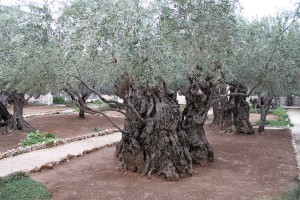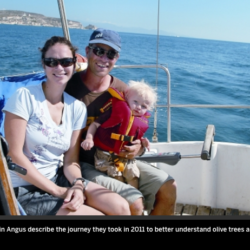 In the cradle of civilization, where church bells chime, the muezzin’s prayer calls, and Judaism’s most holy site beckons, the story of the olive begins. Here, in what was once part of Phoenicia, now Israel, our expedition to uncover the story of the world’s most influential fruit draws to an end.History is palpable, presenting itself around every corner as mounds of stones, remarkably preserved ruins, pottery shards and even as living ancient olive trees, testament to the work of farmers hundreds or even thousands of years ago. It is here in the lands that are now Syria, Lebanon, Jordan and Israel that methods for producing olive oil were first devised and where the olive tree was first domesticated some 7000 years ago.
In the cradle of civilization, where church bells chime, the muezzin’s prayer calls, and Judaism’s most holy site beckons, the story of the olive begins. Here, in what was once part of Phoenicia, now Israel, our expedition to uncover the story of the world’s most influential fruit draws to an end.History is palpable, presenting itself around every corner as mounds of stones, remarkably preserved ruins, pottery shards and even as living ancient olive trees, testament to the work of farmers hundreds or even thousands of years ago. It is here in the lands that are now Syria, Lebanon, Jordan and Israel that methods for producing olive oil were first devised and where the olive tree was first domesticated some 7000 years ago.
For the last four months we have been exploring the old-world olive groves around the Mediterranean, beginning at its western reaches and moving inexorably closer to the tree’s origin in the Middle East.Throughout our journey we spent time with researchers, farmers, chefs, historians, archaeologists, distributors and health experts to reveal the full character of this nuanced fruit.One of the most controversial questions relating to the olive is how did the domestic tree spread throughout the Mediterranean from its origins in the Middle East.The most common theory is that early seafaring Phoenician traders distributed trees in the way of saplings or seeds, or perhaps simply conveyed knowledge of how to domesticate wild trees.Researchers using modern DNA analysis to compare trees have been able to fill in some of the missing pieces, however, the definitive answer is yet to be determined.Regardless of precisely how this process took place, we were excited to finally arrive in the place where it all began.
Dr. Zohar Kerem, an olive researcher from the University of Jerusalem, took us to see some of the oldest olive trees in Israel – living fossils containing a treasure in their ancient DNA.Three hours north of Jerusalem he brought us to a grove of massive trees, their 10+ metre girths twisted and wizened like the faces of old men. These trees, silent witnesses to thousands of years of history, belonged to Nasir Khateeb, a middle-aged Arab farmer with a warm smile and a gift for storytelling, and have been in his family for centuries.
As I examined the largest tree in the grove, a behemoth with the circumference of an airplane, Nasir tapped the trunk and turned to me, “You know the story of Noah?”
“Of course,” I said.
“This is the tree.The dove came here and took a branch.He brought it to Noah to show that the flood was over and there was land to go to.”
If there was any tree that fit the bill, this one would be it.We were on a hill in the Holy Land, at the highest point where olive trees could grow, and Nasir’s olive trees could very well be the oldest in existence.I snipped a few small branches from this fabled tree, so the DNA could later be analyzed.
We carried on to some of the most notable sites in Israel relating to the olive.With the same passion and dedication he applies to his work, Dr. Kerem took us on a whirlwind tour, squeezing a week’s worth of olive sightseeing into a day.We saw ancient olive presses where logs press oil between thick mats and visited a donkey-powered olive mill that is still in use. We were escorted to numerous groves of ancient olive trees, farmers plucking the ripe fruit to be crushed and pressed later in the day.
It seemed everywhere we looked the story of the olive shouted out to us.Ancient Phoenician ports stretching north of Tel Aviv hinted of the beginning of long dangerous sea voyages carrying olives and knowledge to the rest of the word. Jerusalem’s Mount of Olives combines olive trees with some of the most significant events in religious history.And uprooted and burned trees in the West Bank, spoke of the struggle between maintaining family tradition in the face of political difficulties that are an unfortunate part of modern-day Palestine.Production of fair-trade olive oil is a means of helping the ravaged economy, but exporting it from walled-in and heavily controlled West Bank is anything but easy.
We left the Middle East with not only a greater insight into the vital role the olive has played historically and today but also with a greatly expanded collection of ancient olive tree samples for genetic analysis.With the help of Dr. Luciana Baldoni at the Institute of Plant Genetics in Perugia Italy we will uncover much more of the genetic story of these trees, and perhaps shed more light on whether the Phoenicians or other early explorers helped disperse the olive tree throughout the Mediterranean.
We are now home in Canada. Our bags are unpacked, the cat is almost back (she’s fallen in love with our neighbours, who have been caring for her, and their dog,) and we’re getting ready for Christmas.
Over the next few months I’ll be completing my book on this journey and Colin will be producing the documentary.Leif is also pretty excited to be home; his toys are once again brand new and exciting, although I don’t think that will last long.
We hope you’ve enjoyed travelling with us on our Olive Odyssey journey and we look forward to sharing the book and film with you.

























